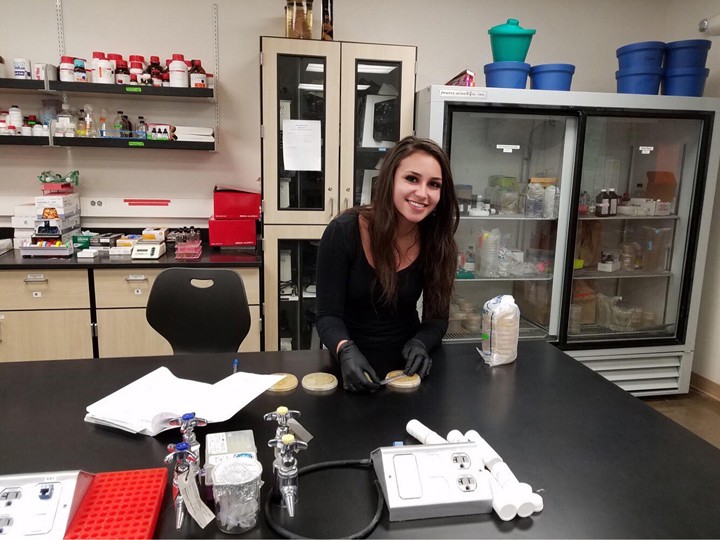Research at undergraduate level launches students into chosen fields

ALAMOSA – The growing resistance to antibiotics continues to be an ongoing concern in the medical profession. Adams State University cellular/molecular biology majors Wyanet Bresnitz, Austin Baumeister, and Jordan Jackson had the opportunity to work on a national consortium effort known as the Prevalence of Antibiotic Resistance in the Environment Project.
When Bresnitz, Alamosa High School Class of 2017, approached Dr. Adam Kleinschmit, associate professor of biology, regarding a research project he suggested characterizing the level of antibiotic resistance in sediment associated with storm water drainage flowing into the Rio Grande. “He immediately took me under his wing and put me on this research project.”
From environmental samples obtained at a city of Alamosa storm water drainage discharge point the students obtained bacteria, carried out a culture-dependent assay, and calculated the prevalence of antibiotic resistant microbes within the sample. Bresnitz’s contribution to the research was conducting a Kirby-Bauer Disk Diffusion Assay on the bacteria, which ultimately tested for multiple drug resistance. “I was able to compare the prevalence of multiple drug resistance of tetracycline resistant bacterial isolates to the prevalence of multiple drug resistance of random bacterial isolates that were not raised on media containing tetracycline.”
The data from this experiment suggested that microbes that exhibit resistance to tetracycline exhibit greater resistance to other antibiotics as well in comparison to those that were not grown on tetracycline infused media. “Because antibiotic resistance is increasingly more prevalent, antibiotic resistance in the environment, which likely cycles into clinical settings, is a very important area of study within cellular and molecular biology, and I am endlessly thankful I got to be a participant in this research.”
Identifying the microbes Bresnitz found to be multidrug resistant, Baumeister’s research was complementary. He worked with Bresnitz to isolate tetracycline-resistant bacterial colonies and then took each of those colonies and isolated the genomic DNA. He used PCR to enrich for the 16s RNA gene, which he then used to identify the taxonomy of the colonies. “This opportunity will help me in my future career in the medical field, because I now have a good background in antibiotic resistance.”
Bresnitz plans on becoming a physician. “As antibiotic resistance increases, the pace of the arms race to find ways to combat this does as well. Having the opportunity to grow and observe bacteria every day for that period of time and get a first-hand look at how bacteria behave in conditions where antibiotic is present was very eye-opening and fascinating, and to be honest, a bit terrifying. Within medicine, antibiotic resistance is a very scary thing, and this research, although focusing on soil bacteria, provided insight on the severity of the overall issue.”
After graduation on May 12, Baumeister will volunteer with AmeriCorps PALS program, working with young children. “I will also begin the process of applying to medical school in hopes of attending medical school in the fall of 2019.”
Although pursuing a degree in cellular/molecular biology requires dedication, Bresnitz marvels at the complexity of life. “My passion for learning about the mechanisms of life and all of its beautiful complexity makes it all worthwhile. I can honestly say that I look forward to attending my classes and extending my knowledge about the science behind life. I absolutely love my major.”
The three students worked well together. “I am so thankful that I had the opportunity to work with Austin and Jordan, Bresnitz added. “They are two of the most intelligent, kind, and funny human beings I’ve met. Working with them was a great privilege.”
Bresnitz, Jackson, and Baumeister received first place at the 2018 Western-1 Regional Beta Beta Beta Biological Honor Society Undergraduate Research Conference for their research presentation. “I think the greatest satisfaction was knowing we did Dr. Kleinschmit proud,” Bresnitz said. “Dr. K helped me tremendously in so many ways.”
Funding for different components of the research was provided by a U.S. Department of Education grant sponsored Adams State University Title V Research and Engagement Grant and Porter Scholars in Mathematics and Science.
Caption: Adams State cellular/molecular biology student Wyanet Bresnitz measures the zones of inhibition of the various antibiotics. The bacterial colonies isolated were transferred onto Mueller-Hinton Agar plates and small disks containing select antibiotics were spatially distributed on the surface of each plate. After incubation, there would be void circles around the antibiotic disks with no bacterial growth. The diameter of this area where the antibiotics inhibited bacterial growth is called the zone of inhibition./Photo by Dr. Adam Kleinschmit



